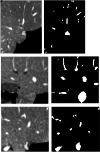Hepatic vessels segmentation using deep learning and preprocessing enhancement
- PMID: 36933239
- PMCID: PMC10161019
- DOI: 10.1002/acm2.13966
Hepatic vessels segmentation using deep learning and preprocessing enhancement
Abstract
Purpose: Liver hepatic vessels segmentation is a crucial step for the diagnosis process in patients with hepatic diseases. Segmentation of liver vessels helps to study the liver internal segmental anatomy that helps in the preoperative planning of surgical treatment.
Methods: Recently, the convolutional neural networks (CNN) have been proved to be efficient for the task of medical image segmentation. The paper proposes an automatic deep learning-based system for liver hepatic vessels segmentation of Computed Tomography (CT) datasets from different sources. The proposed work focuses on the combination of different steps; it starts by a preprocessing step to improve the vessels appearance within the liver region of interest in the CT scans. Coherence enhancing diffusion filtering (CED) and vesselness filtering methods are used to improve vessels contrast and intensity homogeneity. The proposed U-net based network architecture is implemented with modified residual block to include concatenation skip connection. The effect of enhancement using filtering step was studied. Also, the effect of data mismatch used in training and validation is studied.
Results: The proposed method is evaluated using many CT datasets. Dice similarity coefficient (DSC) is used to evaluate the method. The average DSC score achieved a score 79%.
Conclusions: The proposed approach succeeded to segment liver vasculature from the liver envelope accurately, which makes it as potential tool for clinical preoperative planning.
Keywords: CED; U-net; abdominal CT; deep learning; residual block; vasculature segmentation.
© 2023 The Authors. Journal of Applied Clinical Medical Physics published by Wiley Periodicals, LLC on behalf of The American Association of Physicists in Medicine.
Conflict of interest statement
The authors declare no conflict of interest.
Figures
Similar articles
-
Hepatic and portal vein segmentation with dual-stream deep neural network.Med Phys. 2024 Aug;51(8):5441-5456. doi: 10.1002/mp.17090. Epub 2024 Apr 22. Med Phys. 2024. PMID: 38648676
-
Abdomen CT multi-organ segmentation using token-based MLP-Mixer.Med Phys. 2023 May;50(5):3027-3038. doi: 10.1002/mp.16135. Epub 2022 Dec 20. Med Phys. 2023. PMID: 36463516 Free PMC article.
-
Deep learning and level set approach for liver and tumor segmentation from CT scans.J Appl Clin Med Phys. 2020 Oct;21(10):200-209. doi: 10.1002/acm2.13003. Epub 2020 Aug 10. J Appl Clin Med Phys. 2020. PMID: 33113290 Free PMC article.
-
From CNN to Transformer: A Review of Medical Image Segmentation Models.J Imaging Inform Med. 2024 Aug;37(4):1529-1547. doi: 10.1007/s10278-024-00981-7. Epub 2024 Mar 4. J Imaging Inform Med. 2024. PMID: 38438696 Free PMC article. Review.
-
Deep learning image segmentation approaches for malignant bone lesions: a systematic review and meta-analysis.Front Radiol. 2023 Aug 8;3:1241651. doi: 10.3389/fradi.2023.1241651. eCollection 2023. Front Radiol. 2023. PMID: 37614529 Free PMC article. Review.
Cited by
-
Progress and clinical translation in hepatocellular carcinoma of deep learning in hepatic vascular segmentation.Digit Health. 2024 Nov 3;10:20552076241293498. doi: 10.1177/20552076241293498. eCollection 2024 Jan-Dec. Digit Health. 2024. PMID: 39502486 Free PMC article. Review.
-
Efficient Extraction of Coronary Artery Vessels from Computed Tomography Angiography Images Using ResUnet and Vesselness.Bioengineering (Basel). 2024 Jul 26;11(8):759. doi: 10.3390/bioengineering11080759. Bioengineering (Basel). 2024. PMID: 39199717 Free PMC article.
-
Automated segmentation of liver and hepatic vessels on portal venous phase computed tomography images using a deep learning algorithm.J Appl Clin Med Phys. 2024 Aug;25(8):e14397. doi: 10.1002/acm2.14397. Epub 2024 May 21. J Appl Clin Med Phys. 2024. PMID: 38773719 Free PMC article.
-
Improved segmentation of hepatic vascular networks in ultrasound volumes using 3D U-Net with intensity transformation-based data augmentation.Med Biol Eng Comput. 2025 Jul;63(7):2133-2144. doi: 10.1007/s11517-025-03320-2. Epub 2025 Feb 13. Med Biol Eng Comput. 2025. PMID: 39939404
-
Semantic Segmentation of CT Liver Structures: A Systematic Review of Recent Trends and Bibliometric Analysis : Neural Network-based Methods for Liver Semantic Segmentation.J Med Syst. 2024 Oct 14;48(1):97. doi: 10.1007/s10916-024-02115-6. J Med Syst. 2024. PMID: 39400739 Free PMC article.
References
-
- Alirr OI, Rahni AAA, Golkar E. An automated liver tumour segmentation from abdominal CT scans for hepatic surgical planning. Int J Comput Assist Radiol Surg. 2018;13(8):1169‐1176. - PubMed
-
- Alirr OI, Rahni AAA. An automated liver vasculature segmentation from CT scans for hepatic surgical planning. Int J Integr Eng. 2021;13(1):188‐200. - PubMed
-
- Sanchez‐Castro F‐J, Thierry L, Mory B, Ardon R. Automatic inferior vena cava segmentation for hepatic surgery planning in contrast‐enhanced ct images. Computer Assisted Radiology and Surgery, 24th International Congress and Exhibition (CARS’2010); 2010;5(1):118‐119.
-
- Alirr OI, Ashrani AA. Automatic atlas‐based liver segmental anatomy identification for hepatic surgical planning. Int J Comput Assist Radiol Surg. 2020;15(2):239‐248. - PubMed
MeSH terms
LinkOut - more resources
Full Text Sources






